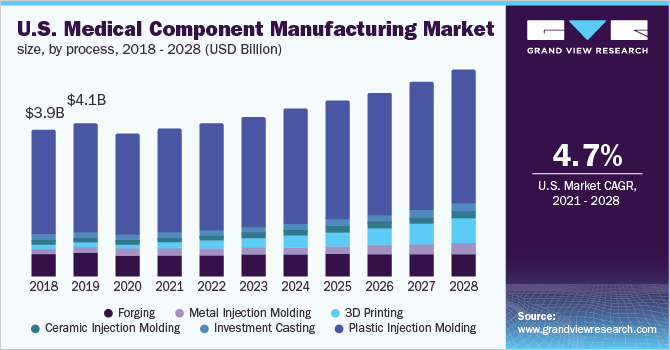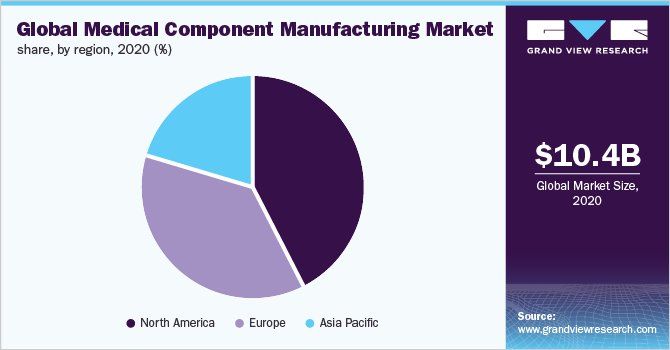- Home
- »
- Advanced Interior Materials
- »
-
Medical Component Manufacturing Market Report, 2030GVR Report cover
![Medical Component Manufacturing Market Size, Share & Trends Report]()
Medical Component Manufacturing Market Size, Share & Trends Analysis Report By Process (Plastic Injection Molding, 3D Printing, Forging), By Region (North America, Europe, Asia Pacific), And Segment Forecasts, 2021 - 2030
- Report ID: GVR-4-68039-807-3
- Number of Report Pages: 92
- Format: PDF, Horizon Databook
- Historical Range: 2017 - 2019
- Forecast Period: 2021 - 2030
- Industry: Advanced Materials
Report Overview
The global medical component manufacturing market size was valued at USD 10.36 billion in 2020 and is expected to expand at a compound annual growth rate (CAGR) of 4.4% from 2021 to 2030. Rising demand for medical devices owing to the prevalence of lifestyle-related diseases and increasing demand for healthcare services and smart devices, such as wearables, are projected to fuel the market growth over the forecast period. There has been a transformation in the methods of treatment and diagnosis with the rising use of wearables and other healthcare equipment at home. Clinicians and doctors receive intelligence from wearables and devices to prevent and monitor diseases and patients avoid unnecessary trips to hospitals.

The U.S. is one of the leading markets for medical devices around the world. It is known for the latest technology and innovative products around the world. Investments in the R&D of such devices have more than doubled in recent decades. This is projected to push the market growth for medical component manufacturing over the coming years.
The presence of a large number of medical device companies drives the demand for components used in medical devices. Some of the states with a large number of medical device companies are New York, Florida, California, Illinois, Michigan, Pennsylvania, and Georgia. The U.S. also holds a competitive edge in several sectors, including biotechnology, instrumentation, telecommunications, microelectronics, and software development, on which the market for medical component manufacturing relies.
Government policies and trade agreements such as NAFTA and TPP, rising healthcare expenditure, and increasing penetration of smart healthcare devices are projected to further push the market demand. As per the Centers for Medicare & Medicaid Services, the national healthcare expenditure in the country increased to USD 3.8 trillion in 2019-4.6% more than in 2018. As per the same resource, the national healthcare expenditure is expected to reach USD 6.2 trillion by 2028.
The COVID-19 pandemic negatively impacted the demand for medical devices, thereby affecting the market growth. The healthcare industry witnessed a fall in elective healthcare procedures, many of which were postponed or canceled so that hospitals could focus on the treatment of COVID-19 patients. However, the demand for products such as personal protective equipment (PPE), ventilators, and diagnostic kits increased rapidly during the COVID-19 outbreak.
Process Insights
Plastic injection molding held the largest revenue share of over 65.0% in 2020. The plastic injection molding process involves the melting of plastics (thermoplastics/thermosetting polymers) to make them malleable. It is followed by injecting them into cavities at a certain pressure. These plastics are then cooled, and they solidify to obtain desired shapes. This process offers several advantages and is used for the production of components, medical devices, laboratory equipment, etc.
Advantages of the plastic injection molding process include the ability of the components manufactured using this process to meet regulatory standards and exact specifications of the healthcare industry. The plastic injection molding process is used to develop surgical equipment and parts; housings and casings for laboratory equipment; test tubes, beakers, and other containers; drug delivery equipment and components; and orthopedic products.
The 3D printing segment is projected to remain the fastest-growing segment and achieve double-digit growth over the forecast period. The 3D printing process is used to develop surgical instruments such as hemostats, needle drivers, scalpel handles, medical clamps, retractors, and forceps; customized body parts and prosthetics; orthopedic implants for hips, knees, and wrists; and equipment and instruments.
The forging segment was the second-largest segment in 2020. The forging process prevents wastage, which occurs during the machining process of workpieces that compromises their mechanical strength and results in the formation of sharp edges and burrs in them. Components produced using the forging process include prosthetic knee joints, respirator valves, leg braces, hip joint swivels, hospital bed parts, PET and MRI scanners, hip stems, hearing aid devices, dental implants, customized devices, etc.
Regional Insights
North America held the largest revenue share of over 40.0% in 2020. Increasing investments in healthcare and rising demand for healthcare products in the U.S., Canada, and Mexico are expected to boost the demand for medical component manufacturing in the region. The aging population, along with the extended life expectancy, is projected to push the demand for medical devices and related products.
In the North American market, the U.S. accounted for the largest revenue share of over 85.0% in 2020 and is projected to maintain its lead over the forecast period. The presence of numerous medical device companies in the country is projected to attract significant demand for medical components. Some of the leading companies include GE Healthcare Technologies, Medtronic, Johnson & Johnson, Boston Scientific, Stryker Corporation, St. Jude, Becton Dickinson, Beckman Coulter, and Baxter.

The European market is one of the largest in the world and attracts significant demand for medical products. The total healthcare expenditure in Europe was around USD 1.8 trillion as of 2019 and accounted for a share of nearly 8.3% in GDP. Out of total healthcare expenditure, the government held a share of 78%. Rising demand for dental and body contouring implants in the region is also anticipated to bolster the demand for medical components over the forecast period.
Asia Pacific is home to seven of the world’s ten most populous countries and accounts for 60% of the global population. Thus, the region is likely to attract significant demand for healthcare products over the coming years. In addition, factors such as expanding the private healthcare sector, rising income levels, and government incentives for medical device companies are projected to boost the demand for medical devices in the region, thus benefiting the market growth.
Key Companies & Market Share Insights
The market is extremely competitive owing to the presence of numerous players across the world. Surging demand for components for use in healthcare applications and the development of medical devices is prompting the key players to expand in their target markets and enhance their global footprint.
Companies are enhancing their product offerings. This has enabled them to establish a strong position in the market in terms of strategic positioning of their R&D centers, significant adoption of different growth strategies, the conduct of advancements in technology, and diversification of their product portfolios. These companies compete with each other based on technologies and product innovations and developments to cater to the requirements of various applications. Some prominent players in the global medical component manufacturing market include:
-
Anchor Harvey
-
Rejointsrl
-
Nexxt Spine, LLC
-
3D Systems, Inc.
-
Heraeus Holding
-
Simalex
-
American Casting Company
Medical Component Manufacturing Market Report Scope
Report Attribute
Details
Market size value in 2021
USD 10.73 billion
Revenue forecast in 2030
USD 15.93 billion
Growth Rate
CAGR of 4.4% from 2021 to 2030
Base year for estimation
2020
Historical data
2017 - 2019
Forecast period
2021 - 2030
Quantitative units
Revenue in USD billion and CAGR from 2021 to 2030
Report coverage
Revenue forecast, company ranking, competitive landscape, growth factors, and trends
Segments covered
Process, region
Regional scope
North America; Europe; Asia Pacific
Country scope
U.S.; Germany; France; U.K.; Spain; China; India; Japan
Key companies profiled
Anchor Harvey; Rejointsrl; Nexxt Spine, LLC; 3D Systems, Inc.; Heraeus Holding; Simalex; American Casting Company
Customization scope
Free report customization (equivalent up to 8 analysts working days) with purchase. Addition or alteration to country, regional & segment scope.
Pricing and purchase options
Avail customized purchase options to meet your exact research needs. Explore purchase options
Segments Covered in the ReportThis report forecasts revenue growth at the global, regional, and country levels and provides an analysis of the latest industry trends and opportunities in each of the sub-segments from 2017 to 2030. For this study, Grand View Research has segmented the global medical component manufacturing market report based on process and region:
-
Process Outlook (Revenue, USD Billion, 2017 - 2030)
-
Forging
-
Metal Injection Molding
-
3D Printing
-
Ceramic Injection Molding
-
Investment Casting
-
Plastic Injection Molding
-
-
Regional Outlook (Revenue, USD Billion, 2017 - 2030)
-
North America
-
U.S.
-
-
Europe
-
Germany
-
France
-
U.K.
-
Spain
-
-
Asia Pacific
-
China
-
India
-
Japan
-
-
Frequently Asked Questions About This Report
b. The medical component manufacturing market size was estimated at USD 10.36 billion in 2020 and is expected to reach USD 10.73 billion in 2021.
b. The medical component manufacturing market is expected to grow at a compound annual growth rate of 4.4% from 2021 to 2030 to reach USD 15.93 billion by 2030
b. North America dominated the medical component manufacturing market with a revenue share of over 42% in 2020. This is attributable to increasing demand for medical and smart devices along with ageing population.
b. Some of the key players operating in the medical component manufacturing market include Anchor Harvey, Rejoint srl, Nexxt Spine, LLC, 3D Systems, Inc., Heraeus Holding, Simalex and American Casting Company
b. Key factors that are driving the medical component manufacturing market growth include rising healthcare expenditure around the world coupled with growing medical device industry
Share this report with your colleague or friend.
![gvr icn]()
NEED A CUSTOM REPORT?
We can customize every report - free of charge - including purchasing stand-alone sections or country-level reports, as well as offer affordable discounts for start-ups & universities. Contact us now
![Certified Icon]()
We are GDPR and CCPA compliant! Your transaction & personal information is safe and secure. For more details, please read our privacy policy.
We are committed towards customer satisfaction, and quality service.
"The quality of research they have done for us has been excellent."





